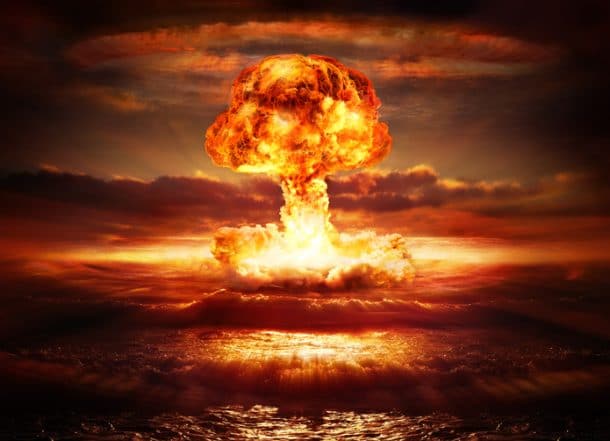
80 Years After Trinity, the Dangers of
Nuclear War Have Never Been Higher
Norman Solomon / The Nation
(July 15, 2025) — The dangers of nuclear war have never been higher, but political pressure to prevent it is at low ebb. Eighty years after the atomic age began with the Trinity bomb test in New Mexico on July 16, 1945, words can’t possibly be adequate to describe the extent of global horrors that today’s nuclear arsenals are capable of inflicting. But mainstream US media outlets and partisan politics are routinely oblivious to the threat of oblivion.
Despite the efforts of individuals and groups striving for arms control, the national discourse ignores the likely results of nuclear buildups—which continue to boost the actual risks of annihilation. Pronouncements from the nuclear establishment about a need to “maintain deterrence” and “modernize” usually go unquestioned as to the underlying assumptions. Senators and representatives praise nuclear systems with components produced in their state or district.
Even well-informed and dedicated advocates of halting the arms race are often reduced to arguing for fiscal responsibility. Within the narrow confines of regular “national security” debates, the wisest lobbying tactic appears to be a focus on exorbitant costs of “modernizing” nuclear weapons. Yet cost-cutting arguments bypass how the weapons push the world closer to doomsday.
Northrop Grumman—the contractor for the new Sentinel ICBM, which is meant to replace the current Minuteman III intercontinental ballistic missiles—has racked up such huge cost overruns that the project at times seemed to be in jeopardy of cancellation. Meanwhile, the political response detoured around the unique dangers of ICBMs, which (as land-based missiles vulnerable to attack) remain on hair-trigger, “use them or lose them” alert. Given the long record of false alarms, such hypervigilance is a possible tripwire for an accidental apocalypse.
“Getting trapped in an argument about the cheapest way to keep ICBMs operational in their silos is ultimately no-win,” Daniel Ellsberg and I wrote for The Nation in autumn 2021. We added: “Better sooner than later, members of Congress will need to face up to the horrendous realities about intercontinental ballistic missiles. They won’t do that unless peace, arms-control, and disarmament groups go far beyond the current limits of congressional discourse—and start emphasizing, on Capitol Hill and at the grassroots, the crucial truth about ICBMs and the imperative of eliminating them all.”
More than 700 scientists signed a letter last summer going beyond the focus on cost to urge the complete elimination of America’s ICBMs. The letter, organized by the Union of Concerned Scientists, explained that “the US could eliminate the land-based leg of the triad tomorrow and the US public would only be safer for it.”
Progressives working to defund new weapons systems recognize that massive military spending is, in the words of Martin Luther King Jr., a “demonic, destructive suction tube”—depleting enormous resources that should be devoted to meeting human needs instead of destroying lives and threatening human survival. But for typical Congress members of either party, disputes about how to get the most bang for the buck are affirming the arms race rather than impeding it. Certain firms might lose specific contracts if some Strangelovian projects are sufficiently exposed as boondoggles, but the nuclear-arms industry and overall military business remain on a steep upward trajectory.
Congresspeople are accustomed to juggling billions of “defense” dollars. What they aren’t accustomed to acknowledging—and what constituent pressure should demand they face—is that the latest weapons systems further endanger human life on Earth.
The history of the last eight decades tells us that Americans will go along with astronomical spending for nuclear weaponry if they believe it makes them safer. Unless we effectively make the case that the opposite is true, the nuclear arms race will continue to play out in media and politics as a pricey necessity.
In recent years, numerous activists and groups have given priority to calling for abolition of nuclear weapons. It’s a position that occupies the highest moral ground, famously seized by the Nobel laureate scientist George Wald in a widely reprinted 1969 anti-war speech at MIT. “Nuclear weapons offer us nothing but a balance of terror, and a balance of terror is still terror,” he said. “We have to get rid of those atomic weapons, here and everywhere. We cannot live with them.”
After the Bombs
During the past several years, accelerating work by activists for abolition has drawn inspiration from the Treaty on the Prohibition of Nuclear Weapons, now signed by 94 countries, and visionary organizations like the International Campaign to Abolish Nuclear Weapons.
Unfortunately, campaigning for abolition of nuclear weapons does not have any evident capacity to hinder the US government’s leading role in propelling the momentum of the arms race. No matter how heartfelt and imbued with wisdom, pleas for abolition do not present a threat to the unrestrained and voracious power of the military-industrial complex.
A truly horrific reality in 2025, and for the realistically foreseeable future, is that nuclear weapons will remain on this planet, brandished against the entire human species. The word “realistically” may cause some to bristle. But a lack of such distasteful realism can divert resources, time, and energies away from where they’re most needed.
Desperate needs include far greater activism, public messaging, and political organizing to avert the worst. The top of the agenda should include: renewal of US-Russia New START treaty set to expire next February; reinstatement of three vital nuclear-arms pacts canceled by the US government, the Anti-Ballistic Missile, Intermediate-Range Nuclear Forces, and Open Skies treaties; and initiation of step-by-step disarmament measures that can sometimes involve wise unilateral actions by the US government, as in the case of ICBMs.
“We are closer to nuclear catastrophe today than at any point since the Cold War,” Representative Jim McGovern said this spring when reintroducing a House resolution “urging the United States to lead the world back from the brink of nuclear war and halt and reverse the nuclear arms race.” With 21 cosponsors, the resolution “calls on the president” to take major steps toward sanity, none of which Joe Biden chose to take and none of which Donald Trump shows any indication of taking.
Looking at the names on the nonbinding resolution, a reason for discouragement is that only 10 percent of House Democrats and not a single Republican signed on. A less obvious problem is that the signers are not speaking out for vigorous American diplomacy to end the Ukraine war, which may be a prerequisite for restarting any semblance of dialogue on nuclear dangers between Washington and Moscow.
For more than three years, ever since the Russian invasion of Ukraine, congressional Democrats have rarely advocated the kind of diplomatic efforts that might stop the war’s carnage. Such efforts could supply a scaffold for rebuilding the arms-control architecture.
But the default role for even progressive Democrats on the Hill has been to support no-strings arming of the Ukrainian military (“let’s you and them fight”) while depicting the Kremlin as incapable of serious negotiations. Yet the McGovern resolution says that the United States should lead a worldwide effort to prevent nuclear war by “in particular, pursuing and concluding new nuclear arms control and disarmament arrangements with the Russian Federation to prevent a buildup of nuclear forces beyond current levels.”
So while some congressional Democrats are emphatic that the United States should directly negotiate with Russia to prevent nuclear war, those same lawmakers are not willing to push for US negotiations with Russia to end the Ukraine war.
In reality, thawing the deep freeze of the new Cold War is essential to halt and reverse the race toward annihilation. Voicing hope that nuclear-arms negotiations can be successful in tandem with belligerence toward Russia may seem politic, but it is not realistic.
While hawkish legislators make no pretense of interest in any step toward détente, it’s important that at least a minority of Democrats at the Capitol are urging diplomatic talks aimed at preventing nuclear war. Yet it’s hard to imagine those Democrats sounding anything like President Lyndon B. Johnson at the close of his summit with Russian Premier Alexei Kosygin in mid-1967 in Glassboro, New Jersey, when LBJ said, “We have made further progress in an effort to improve our understanding of each other’s thinking on a number of questions.”
Today, the Democrats who talk about the need to avoid nuclear war do not seem especially interested in “an effort to improve our understanding” of the Russian leadership’s thinking. The rote storyline—that Vladimir Putin is evil, end of story—blends in smoothly with US news media and the punditocracy. What it also does is give more fuel to the momentum toward nuclear holocaust.

Many who justifiably derided President George W. Bush after 9/11 for his Manichaean view of the world are now largely replicating it. Implicit in the current worldview is that—after decades of war in Afghanistan and Iraq, causing deaths into the millions, and now while continuing to serve as the crucial accomplice for ongoing genocide in Gaza—the US government is clearly virtuous, in complete contrast with the Russian government because of its own unconscionable aggression in Ukraine.
The prevailing reflex, to act as though US-Russia relations could roll along on two tracks—escalating geopolitical conflicts while restoring and concluding major nuclear-arms treaties—is the political equivalent of magical thinking, if not simply craven expediency.
Meanwhile, for the corporate beneficiaries of a trillion-dollar Pentagon budget and an out-of-control nuclear weapons program, the more hostility toward Russia and China the better. And the country that first brought atomic weapons into the world is continuing to lead the way toward thermonuclear destruction.
For those of us who have lived in the era of nuclear bombs for many decades, still being alive can seem close to miraculous. Luck and collective efforts for sanity must have been factors. Now, the generations with most of their lives potentially ahead are in a world that could instantly make that impossible. The heightened militarism of American politics is threatening to seal their fate.
Posted in accordance with Title 17, Section 107, US Code, for noncommercial, educational purposes.